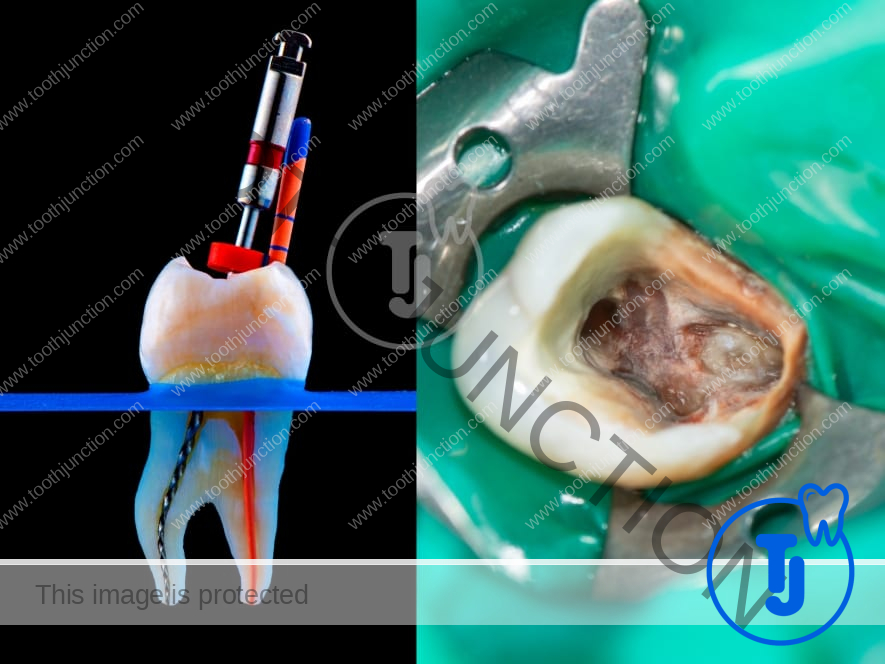Single Sitting Root Canal Treatment
Quick. Painless. Done in One Visit.
Root canal treatment doesn’t have to mean multiple dental appointments and prolonged discomfort. With modern dental advancements, it’s now possible to treat infected teeth in just one sitting—saving your time, easing your nerves, and helping you get back to life faster.
At Tooth Junction, Mahanadi Vihar, Cuttack, we specialize in single sitting root canal treatments that are fast, safe, and highly effective—all without compromising on comfort or care.
What Is a Single Sitting Root Canal?
A single sitting root canal is a streamlined procedure where the entire treatment—removal of infection, cleaning, disinfecting, and sealing the tooth—is completed in just one appointment.
Traditionally, root canal therapy required two or more visits. But thanks to advanced rotary instruments, digital X-rays, and precision anesthesia, everything can now be done in 60–90 minutes, depending on the tooth’s complexity.

Who Should Consider It?
You may be a good candidate for single sitting RCT if you have:
Persistent or throbbing toothache
Sharp sensitivity to hot or cold drinks
Swelling or pus discharge near the gums
A tooth darkened due to trauma or infection
A cracked, chipped, or deep decayed tooth
Our dentists will evaluate your case thoroughly and let you know whether a single visit procedure is right for you.

How Single Sitting RCT Works – Step by Step
Here’s what happens during a single sitting root canal at Tooth Junction:
Benefits of Single Sitting RCT
Time-Saving
One visit is all it takes—ideal for busy individuals or those traveling from out of town.Comfortable Experience
Less exposure to dental tools and anesthesia means reduced stress and faster healing.Lower Risk of Infection
Since there’s no delay between cleaning and sealing, the risk of reinfection is minimized.Better Patient Compliance
No need to return multiple times, making it easier for patients who fear dental visits.Cost-Effective
Fewer appointments mean lower overall treatment costs in many cases.
Aftercare Instructions for Single Sitting Root Canal Treatment
Your tooth is treated — now let’s keep it healing smoothly.
Once your root canal is done, your tooth needs a little time and care to settle and heal. Here’s what you should do (and avoid) to ensure a safe and speedy recovery:
What You Should Do
- Wait Until the Numbness Wears Off
Avoid chewing or drinking hot beverages until the anesthesia completely fades. This prevents accidental biting or burns. - Eat Soft Foods for 24 Hours
Stick to mashed foods, soups, curd, and smoothies. Avoid crunchy or sticky items that can put pressure on the treated tooth. - Take Prescribed Medications
If your dentist has prescribed pain relievers or antibiotics, take them exactly as directed—even if you’re feeling fine. - Keep the Area Clean
Continue brushing and flossing gently. Be cautious around the treated tooth if a temporary filling is placed. - Follow-Up for Final Crown
If a crown is recommended, don’t skip it. A treated tooth becomes brittle over time and needs a crown to protect it from cracking.
What You Should Avoid
Don’t chew hard or crunchy food on the treated side until the final crown is placed.
Avoid smoking or alcohol for at least 24–48 hours as it may delay healing.
Don’t poke the area with your tongue or finger — let it heal naturally.
Skip very hot or cold foods if you experience sensitivity in the first few days.
Don’t ignore unusual symptoms like severe pain, swelling, or bad taste — contact your dentist immediately.
Don’t Forget the Final Step: Crown Placement
Tooth structure becomes weaker after a root canal. So, once healing is complete, a dental crown is usually required to protect the tooth and restore its strength. Don’t delay this final step—it helps your tooth last for years to come.
FAQs
Other Treatments
- All On 4 & 6 Implants
- Bad Breath Treatment
- Braces Treatment
- Ceramic Braces
- Dental Crown & Bridge
- Dental Filling
- Dental Implants
- Dental Veneers
- Dentures
- FMR
- Fluoride & Dental Sealants
- Gum Treatment
- Invisible Braces
- Oral Cancer
- Overdenture
- Preventive Orthodontics For Kids
- Root Canal Treatment
- Self Ligating Braces
- Smile Makeover
- Single Sitting Root Canal Treatment
- Teeth Cleaning
- Teeth Whitening
- Wisdom Tooth Removal
